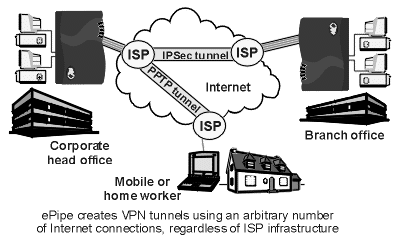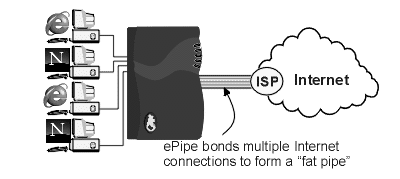
Small businesses have very few options when deploying an Internet-enabled VPN solution, which closes the bandwidth chasm between a single dial-up analog modem and dedicated multi-megabit Internet connection services. For example, in the U.S., business Internet connections are dominated by T1-T3 (1.5 Mb/sec - 45 Mb/sec) services. Analog modem (56 Kb/sec) connections are the next most popular with ISDN and a combination of cable and ADSL connections making up the remainder.
It is clear that small business customers make up the majority of the analog and ISDN Internet users. However a single 56K-modem connection at each site provides insufficient bandwidth for tying together multiple branch office sites through the Internet or, supporting remote users and business partner transactions.
Existing bonding technologies claim to offer some bandwidth scalability by aggregating multiple connections into a single logical connection. However they require ISP provisioning and are very limited in the number of lines they aggregate and the physical connection type they support.
ePipe developed End-to-End Bonding (E2B) specifically to enable SMBs to have cost-effective, scalable, ISP independent bandwidth. This can be used to deploy a VPN over multiple analog modem or ISDN Internet connections, up to 512 K Bits/sec, simply and cost-effectively.

A solution to increasing bandwidth is to use tried and proven bandwidth aggregation methods. These technologies bundle multiple dial-up analog or ISDN PPP connections into a single logical connection to achieve more bandwidth in a scalable fashion. In the Internet world the terms bundling, channel aggregation, channel bonding and link aggregation are often used interchangeably although they don't strictly employ the same methods. This may seem to be a simple way to fix the whole problem. However, there are some practical limitations. When it comes to real-life VPN-based deployments of technologies which support connection bundling, such as the de facto standard Multilink PPP (ML-PPP), the story becomes quite interesting. However, ML-PPP works very well in direct-dial point-to-point scenarios.
ML-PPP was not originally designed to handle an intervening public network between the local network and the remote network. It was developed primarily to connect two or more networks by multiple point-to-point data links to improve bandwidth. Therefore when a public network (such as the Internet) is introduced between the multiple data links at a local site and the multiple data links at a remote site, problems occur if the Points of Presence (PoPs) within the public network lose the association between the links of a bundle. This may occur if one device answers the first call while a different device answers the second call.
To solve this, vendors have developed a variety of protocol extensions in order to identify primary and secondary connections and transfer secondary fragments to the same device as the primary connection. However these have only been broadly deployed using ISDN and therefore ML-PPP connections are primarily offered over ISDN BRI connections and are often limited to one Basic Rate Interface whereby two 64KB channels are bundled into one aggregate 128K connection. In many cases, ISDN is not available at all locations and ISPs very rarely offer ML-PPP over multiple analog modem connections. In the small number of cases where ML-PPP is supported over analog dial-up, it is usually limited to two lines. This leaves small business customers without a guaranteed solution that can easily scale the bandwidth between remote locations regardless of whether they are using analog, digital or a combination of connections to the Internet.

ePipe developed End-to-End Bonding (E2B) specifically to enable SMBs to have cost-effective, scalable, ISP independent bandwidth to deploy a VPN. E2B establishes a peer-to-peer relationship between the ePipe gateways, controlling the multiple Internet connections at each site. It creates an aggregate tunnel (based on a bundle of all the Internet connections) through the Internet between systems needing to communicate. E2B controls bundling, and hence bandwidth, at the user sites and can determine the number of connections that a peer has.
E2B is not hampered by the Internet infrastructure or the particular service offered by an ISP. It can combine an arbitrary number of Internet connections from a site and spread them across a variety of PoPs or different service providers and bundle them into a higher-speed tunnel to a remote peer, giving a further level of resilience. This is impossible with ML-PPP, all connections must terminate at one PoP. E2B can be deployed ubiquitously between sites, giving it a distinct advantage over other solutions and it can operate over a range of Internet connection technologies (PSTN, ISDN, Frame Relay, Leased-lines, ADSL, etc.). However the ePipe 2100 series of dial-up network gateways currently supports PSTN and ISDN connections only, up to 512 Kbps.

 ePipe
developed I2B to enable SMBs to connect to the Internet and scale bandwidth
according to demand. It operates over standard dial-up connections and can
bond 2 to 8 connections transparently into a wider pipe. I2B enables faster
Web browsing and more simultaneous file downloads.
ePipe
developed I2B to enable SMBs to connect to the Internet and scale bandwidth
according to demand. It operates over standard dial-up connections and can
bond 2 to 8 connections transparently into a wider pipe. I2B enables faster
Web browsing and more simultaneous file downloads.
Another advantage of multiple Internet connections is that if a link disconnects or fails the remaining links will continue transmitting data. Other Internet solutions that rely on a single high-speed digital connection to the Internet can leave a site without any communications when that link fails. To provide further redundancy, ePipe with I2B enables organizations to connect to multiple ISPs simultaneously. Even if an entire ISP PoP goes down, your organization's Internet access is maintained.
With E2B, additional connections based on usage can be established and lost connections can be re-established, thus providing a high level of resilience. If a connection within a bundle drops or fails, the remaining connections continue to transfer data. Should the control channel on the initial link be lost due to a connection failure, it is automatically transferred to an operating connection. Bandwidth is configurable by setting connection throughput thresholds with the ability to restrict out of hours access. This allows E2B bandwidth to be tuned for the best performance with the lowest ISP charges. Internet connections that are dropped by the ISP due to idle timeouts or other reasons can be automatically re-established. It is highly unlikely that other VPN solutions using ISP-provisioned ML-PPP can provide this level of bandwidth control and connection recovery that E2B provides.
![]()
about ePipe | products | solutions | support | information center | contact us
Copyright © 2002 ePipe Pty. Ltd. All rights reserved.